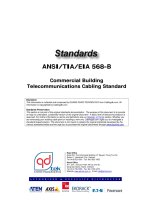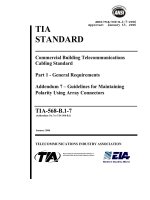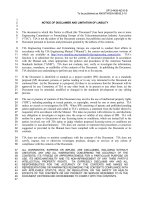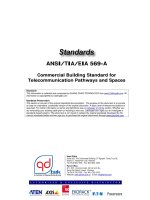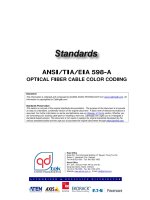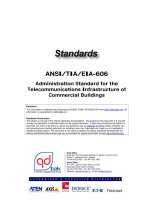Tài liệu Cabling Standard - TIA 607 - Commercial Building Grounding and Bonding Requirements for Telecommu doc
Bạn đang xem bản rút gọn của tài liệu. Xem và tải ngay bản đầy đủ của tài liệu tại đây (95.19 KB, 7 trang )
A
A
N
N
S
S
I
I
/
/
T
T
I
I
A
A
/
/
E
E
I
I
A
A
6
6
0
0
7
7
Commercial Building Grounding and
Bonding Requirements for
Telecommunications
Disclaimer
This information is collected and composed by QUANG DUNG TECHNOLOGY from www.Cablingdb.com. All
information is copyrighted by Cablingdb.com.
Standards Preservation
This section is not part of the original standards documentation. The purpose of this document is to provide
an easy to understand, condensed version of the original document. A basic level of telecommunications is
assumed. For further information on terms and definitions see our Glossary of Terms section. Whether you
are renovating your existing cable plant or installing a new one, Cablingdb.com urges you to investigate a
standards based solution. This document is not meant to replace the original standards developed by the
various standards bodies and we urge you to purchase the original documents through www.tiaonline.com.
AUTHORIZED & EXCLUSIVE DISTRIBUTOR
Head Office
Suite 202, The Colonnade Building, 27 Nguyen Trung Truc St.,
District 1, Hochiminh City, Vietnam
Tel: 84.8 823-1693 Fax: 84.8 823-1665
Hanoi Office
A11, 3/Fl., Horizon Hotel, 40 Cat Linh St.,
Dong Da District, Hanoi, Vietnam
Tel: 84.4 736-7055 Fax: 84.4 733-2470
Website: www.qd-tek.com.vn
Email:
ANSI/TIA/EIA 607 Commercial Building Grounding and Bonding Requirements for Telecommunications
Quang Dung Technology Distribution Company Page 2 of 7
Table of Contents
OVERVIEW
COMPONENTS OF THE TELECOMMUNICATIONS GROUNDING AND BONDING
INFRASTRUCTURE
Identification Elements
Bonding Conductors for Telecommunications
Telecommunications Bonding Backbone (TBB)
Telecommunications Main Grounding Busbar (TMGB)
Telecommunications Grounding Busbar (TGB)
TELECOMMUNICATIONS ENTRANCE FACILITY
TELECOMMUNICATIONS ROOM and EQUIPMENT ROOM
ANSI/TIA/EIA 607 Commercial Building Grounding and Bonding Requirements for Telecommunications
Quang Dung Technology Distribution Company Page 3 of 7
OVERVIEW OF THE TELECOMMUNICATIONS GROUNDING AND
BONDING INFRASTRUCTURE
The electrical service entrance is outside the scope of this Standard and is grounded
and bonded in accordance with all applicable electrical codes.
In all cases the applicable electrical codes for bonding and grounding for
telecommunications shall be met.
The telecommunications grounding and bonding infrastructure begins with a
connection to the service equipment (power) ground and extends throughout the
building.
Although the electrical closet and associated panelboard(s) are not part of the
telecommunications infrastructure, they are referenced because they are integral to
grounding and bonding.
COMPONENTS OF THE TELECOMMUNICATIONS GROUNDING AND
BONDING INFRASTRUCTURE
Major components of the grounding and bonding infrastructure are:
• the identification elements
• the bonding conductor for telecommunications
• the Telecommunications Bonding Backbone (TBB)
• the Telecommunications Main Grounding Busbar (TMGB)
• the Telecommunications Grounding Busbar (TGB)
• the Telecommunications Bonding Backbone Interconnecting Bonding
Conductor (TBBIBC)
All bonding conductors shall:
• be listed for the purpose intended and approved by a Nationally Recognized
Testing Laboratory (NRTL).
• be insulated and copper. The minimum bonding conductor size shall be a No. 6
AWG.
• be bonded to each end of the conduit with a No. 6 AWG ground wire at a
minimum if the conductors are inserted in a metallic conduit longer than 1 m
(3ft)
• be marked appropriately by a distinctive green color.
Labels, Color-Coding, and Markings
Labels shall:
• be attached to each telecommunications bonding conductor
• be located on conductors as close as practicable (ie., ease of access to read
the label) to their point of termination
• be nonmetallic. Refer to ANSI/TIA/EIA 606 for additional labeling
requirements.
Bonding Conductors for Telecommunications
ANSI/TIA/EIA 607 Commercial Building Grounding and Bonding Requirements for Telecommunications
Quang Dung Technology Distribution Company Page 4 of 7
The bonding conductor for telecommunications shall:
• bond the TMGB to the service equipment (power) ground
• be, at a minimum, the same size as the TBB (see below)
The Telecommunications Bonding Backbone (TBB)
The TBB is a conductor:
• that interconnects all TGBs with the TMGB
• reduces or equalizes potential differences between telecommunications
systems bonded to it.
A TBB is not intended to serve as the only conductor providing a ground fault current
return path.
A TBB(s) originates at the TMGB, and connects to the TGB(s) in all
telecommunications closets and equipment rooms.
A TBB design should take into account:
• type of building construction, building size
• the telecommunications requirements
• the configuration of the telecommunications pathways and spaces.
the TBB shall:
• be designed with over all design of the telecommunications backbone cabling
system in mind
• permit multiple TBBs as required
• minimize the lengths of the TBBs
• be an insulated copper conductor
• have minimum conductor size of No. 6 AWG, and as large as No 3 AWG
• be bonded together with a TBB interconnecting bonding conductor (TBBIBC) at
the top floor and at a minimum of every third floor in between when two or
more vertical TBBs are used in a multistory building
• be connected to the TMGB
Water pipes shall not be used as a TBB.
Metallic cable shield shall not be used as a TBB in new installations.
Installation Considerations
TBB conductors:
• shall be protected from physical and mechanical damage
• should be installed without splices, where practicable.
If splices are required, they:
• should be minimum and shall be accessible and located in telecommunications
spaces
• shall be connected using irreversible compression-type connectors,
exothermic welding, or equivalent
• shall have joints adequately supported and protected from damage
ANSI/TIA/EIA 607 Commercial Building Grounding and Bonding Requirements for Telecommunications
Quang Dung Technology Distribution Company Page 5 of 7
The Telecommunications Main Grounding Busbar (TMGB)
The TMBG serves as:
• the dedicated extension of the building grounding electrode system for the
telecommunications infrasfructure
• the central attachment point for telecommunications bonding backbones
(TBB) and equipment, and is located such that it is accessible to
telecommunications personnel
The TMGB should:
• be located in the telecommunications entrance room
• minimize the bonding conductor length for telecommunications
• serve telecommunications equipment that is located within the same room or
space.
Extensions of the TMGB (i.e., other busbars) shall be telecommunications grounding
busbars (TGB). Typically, there should be a single TMGB per building.
The TMGB shall:
• be a predrilled copper busbar provided with standard NEMA bolt hole sizing
and spacing for the type of connectors to be used
• be sized with the immediate requirements and future growth in mind
• have minimum dimensions of 6 mm thick x 100 mm wide and a length as
required.
The TMGB should:
• be electrotin plated for reduced contact resistance or if not plated, the busbar
shall be cleaned prior to fastening of conductors.
Bonding to a Panelboard for Telecommunications
The TMGB shall:
• be as close to the panelboard for telecommunications as is practicable
• maintain clearances required by applicable electrical codes
• have a panelboards Alternating Current Equipment Ground bus, or enclosure
bonded to the TMGB
• use listed 2-hole compression connectors, exothermic type welded
connections, or equivalent for the bonding conductor connections
• be bonded to all metallic raceways used for telecommunications cable within
the same room or space
• be insulated from its support (50mm is recommended)
The TMGB should:
• be located to the side of the panelboard
• be located vertically based on the entrance point of the cables (eg: overhead
or from below)
• use 2 hole compression connectors
